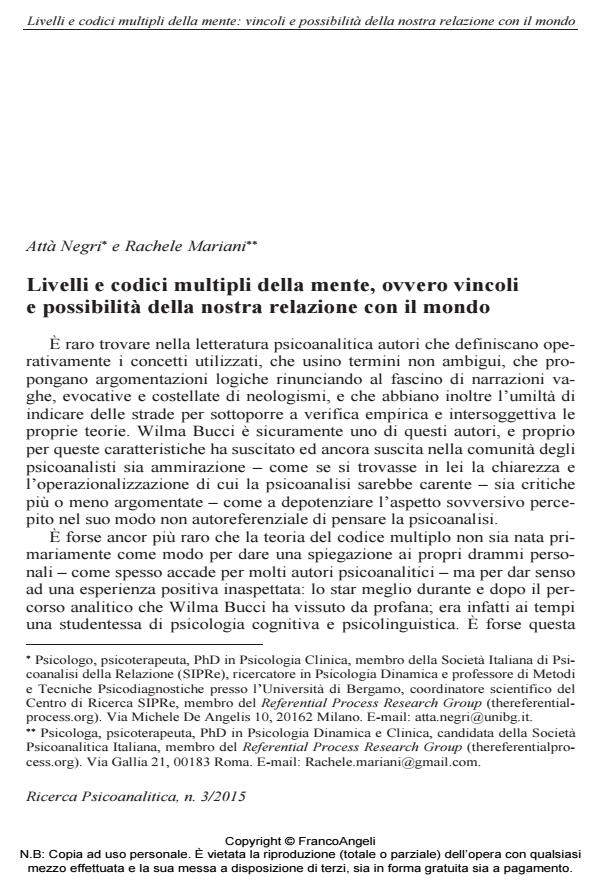Levels and multiple codes of the mind, or constraints and possibilities of our relation with the world
Journal title RICERCA PSICOANALITICA
Author/s Attà Negri, Rachele Mariani
Publishing Year 2015 Issue 2015/3
Language Italian Pages 17 P. 37-53 File size 97 KB
DOI 10.3280/RPR2015-003004
DOI is like a bar code for intellectual property: to have more infomation
click here
Below, you can see the article first page
If you want to buy this article in PDF format, you can do it, following the instructions to buy download credits

FrancoAngeli is member of Publishers International Linking Association, Inc (PILA), a not-for-profit association which run the CrossRef service enabling links to and from online scholarly content.
The authors offer a reading of the multiple code theory of Wilma Bucci both as a theory of the mind, intended as being in relationship with the world, and as a theory of the technique, intended as the hypothesis on how patient-therapist communication can spawn some changes in their being in relationship with the world. In particular they examine - also exemplifying it through the analysis of clinical cases discussed by Wilma Bucci - the process considered essential for therapeutic change: the emergence in the multiform subjective experience of symbols understood as patterns of multimodal sensory experiences in interpersonal communication that becomes defined and recognizable. The words in the talking cure become central only at a later stage and they are primarily the result of this process, not the engine. According to the authors’ hypothesis it is exactly the joint non verbal symbolization of subjective experience that is itself transformative and creative as it deconstructs the constraints of automatic processing that occurs in subsymbolic processing and greatly expands the degree of freedom of the subject. This non verbal symbolic communication in fact gives to analyst and patient the possibility of taking a position with respect to the experiences made recognizable within and because of the relationship in which they are immersed. And that is why psychotherapeutic change can be defined as an embodied, contextual and relational process.
Keywords: Multiple code theory, referential process, change factors, therapeutic relationship, symbolization
- Sulla funzionalità dei sintomi e dei problemi - I pretesti professionali della psicologia clinica Attà Negri, Luca Belotti, in RICERCA PSICOANALITICA 3/2017 pp.21
DOI: 10.3280/RPR2017-003003 - Dreaming in quarantine: linguistic analysis of referential process of dreams during COVID-19 pandemic lockdown Rachele Mariani, Silvia Monaco, Christopher Christian , Michela Di Trani, in Research in Psychotherapy: Psychopathology, Process and Outcome /2021
DOI: 10.4081/ripppo.2021.537
Attà Negri, Rachele Mariani, Livelli e codici multipli della mente, ovvero vincoli e possibilità della nostra relazione con il mondo in "RICERCA PSICOANALITICA" 3/2015, pp 37-53, DOI: 10.3280/RPR2015-003004